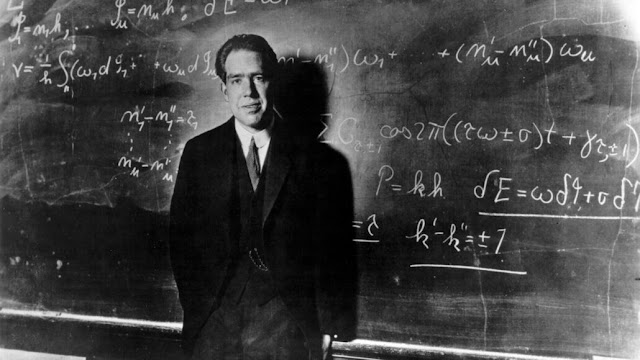A new book clarifies common misconceptions about the work of the Danish physicist.
Physicists have debated whether reality is more like sand or water since Max Planck introduced the concept of the quantum to the world.
Planck’s famous 1900 discovery that energy is grainy — at least when absorbed or emitted — moved him to label those smallest bits of energy grains “quanta.” But he felt that once discharged, as in light from a fire, those grains combined into smooth, continuous waves, just as water resembles a smooth liquid to human sense. Einstein, on the other hand, believed that light quanta moved through space on their own, behaving like the particles that would later be known as photons.
By the mid-1920s, both the wave and particle conceptions of light had garnered experimental support, with the additional conundrum that electrons — purportedly particles — could sometimes disguise themselves as waves.
Into this field of contention walked the great Danish physicist Niels Bohr, the pioneer of examining the architecture of the atom. Resolving the wave-particle contradiction, according to Bohr, necessitated a new conception of reality in which both notions played a role in interpreting experimental facts. In tests meant to investigate waves, waves you would discover, whether electrons or light. In trials designed to detect particles, you’d observe particles. But in no experiment could you demonstrate both at once. This viewpoint was dubbed the principle of complementarity by Bohr, and it successfully steered the research of quantum mechanics in the decades that followed.
More recently, as philosopher Slobodan Perović describes in From Data to Quanta, Bohr’s achievement has been questioned by certain physicists and philosophers and even popular science writers. Complementarity has been criticized as an incoherent application of abstract philosophy presented in unintelligible language. But as Perović’s investigations indicate, such criticisms are rarely anchored in any fundamental grasp of Bohr’s methods. Perovi contends that it is his opponents’ philosophical prejudices, not Bohr’s philosophy, that have led to misstatements, misunderstandings, and misrepresentations of Bohr’s physics. And Bohr can’t be comprehended by seeking to understand his philosophy, Perović maintains, because philosophy did not lead him – tests did.
In fact, Bohr’s desire to understand the wave-particle dilemma was fueled by a genuine devotion to interpreting the experimental evidence in its completeness. It was the same strategy used by the younger Bohr in creating his atomic model in 1913. Various experiments showed features of the atom that seemed incompatible. But Bohr fashioned those experimental signals into a “master hypothesis” that provided a wholly fresh understanding of the atom and its structure.
Perović describes how Bohr’s process began with lower-level hypotheses stemming from features directly given by experiment. Spectral lines — different specific colors of light emitted by atoms — led to basic hypotheses that some vibratory process, of an atom itself or its constituents, produced electromagnetic radiation exhibiting precise patterns. Intermediate ideas regarding the structure of the atom, on the other hand, failed to explain such lines. Then, based on his own experiments, Ernest Rutherford concluded that an atom was mostly empty space. It had a dense, tiny central nucleus that accounted for the majority of the mass, with lightweight electrons orbiting at a safe distance. However, the precise patterns of spectral lines contradicted this hypothesis. And such an atom would be unstable, lasting only a fraction of a second. Bohr used Planck’s quantum idea to construct a master hypothesis from all of these disparate experiment-based hypotheses. He reconciled the spectral lines and Rutherford’s nuclear atom with a novel atomic model, in which electrons maintained stability of the atom but moved from one orbit to another, generating precise patterns of spectral lines in the process.
As Perović explains, Bohr followed a similar course in arriving at complementarity. While several studies shown that light is a wave, during the early 1920s, further experiments demonstrated that X-rays, which are extremely energetic light, collide with electrons as if they were both particles. Bohr’s master hypothesis, complementarity, seemed the only way forward.
Throughout the book, Perović relates how Bohr has been misrepresented, his beliefs misleadingly amalgamated with those of others (such John von Neumann and Werner Heisenberg), and his philosophy mistakenly portrayed as anti realist — suggesting that only observations brought reality into existence. Bohr never said anything like that, and in fact advised against overusing words.
Perovi’s account includes a thorough review of prior historical studies of Bohr’s work, as well as extensive quotations from Bohr’s own writings. It’s a subtle and intelligent account of the interplay of experiment and theory in the scientific process. However, this is not a light read. It is not the place to look for straightforward explanations of quantum physics and Bohr’s interpretation of it. With a penchant for long sentences, Perovi opts for scholarly thoroughness and careful reasoning. But then again, neither were Bohr’s writings a breeze. In fact, a major complaint against Bohr has been made by authors who think his texts are particularly difficult to understand. It’s terrible that so many appear to conclude that because they can’t grasp Bohr, he must have been wrong. Perovi’s book is an effective counter to that mindset.
https://press.uchicago.edu/


